![]() 1st Battalion 22nd Infantry
1st Battalion 22nd Infantry ![]()
George F. Rozelle
1903 - 1922
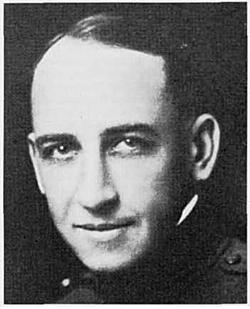 ¹
¹
George F. Rozelle Jr.
George Francis Rozelle, Jr. was born in Arkansas, on January 19, 1878.
He entered the U.S. Military
Academy at West Point on June 18, 1898, and was a member of the
same graduating class as Douglas MacArthur. Rozelle graduated on
June 11, 1903, 68 out of a class of 94,
with a grade average of 82.5 %. His best subjects were Practical
Military Engineering and English and
his worst subjects were Spanish and Chemistry.
Upon graduation Rozelle was
commissioned a 2nd Lieutenant in the 22nd Infantry. He was
assigned to
Company C, and joined them at Fort Logan H. Root, Arkansas, on
September 11, 1903. On October 20, 1903,
he left with his Company for San Francisco, California, where, on
October 31, he sailed aboard the U.S.A.T. Sheridan,
with the Regiment, bound for the Philippine Islands. He arrived
in the Philippines on November 28, 1903, and his
primary duty station was at Camp Keithley, Marahui, on Mindanao,
until November 18, 1905. During the year 1905,
he qualified for the Sharpshooter medal.
He took part in the expedition
to the Ramaien River, in the Lake Lanao region, Mindanao, on
January 22, 1904.
He was with the Provisional Company of the 22nd Infantry on
expedition against Datu Ali, in the Rio Grande Valley
of Mindanao, from August 11, 1904 to January 15, 1905. He was on
leave from November 25 to December 12, 1905.
Returning from leave, Rozelle
joined Company C, 22nd Infantry, at Angel Island, California, on
January 14, 1906,
and was on duty with the 22nd Infantry during the earthquake and
fire in San Francisco in 1906. He was the
Battalion Quartermaster and Commissary, and the Post
Quartermaster and Commissary, Depot of Recruits and Casuals,
Angel Island, California, from May 1, 1906, to September 1, 1907.
He was on leave from September 13, 1907,
to January 12, 1908. He returned to duty at the Presidio of
Monterey, San Francisco, until September, 1908,
when he left to join the Regiment in Alaska.
Instead of leaving with the
Regiment for Alaska in July 1908, Rozelle remained behind,with a
team from the
22nd Infantry, to compete in the annual Pacific rifle and pistol
competition of the Department of the Pacific
and Department of the Columbia. He was an excellent shot with
both rifle and pistol, and qualified as
Expert Rifleman in 1906, 1907 and 1908.
The following newspaper articles
pertain to the shooting competition for the year 1908. Members of
the
22nd Infantry mentioned in the articles are marked with a red
asterisk.
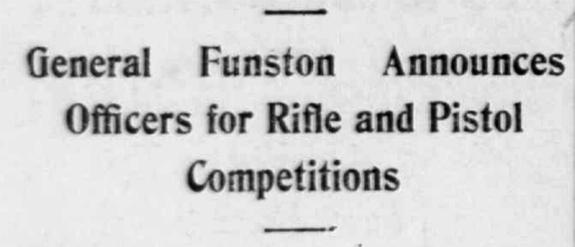
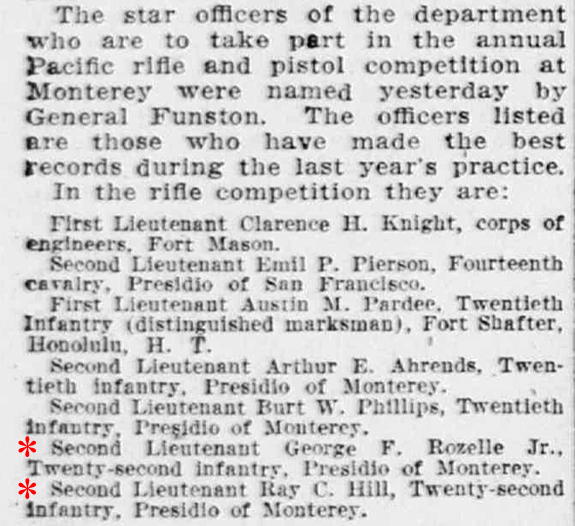
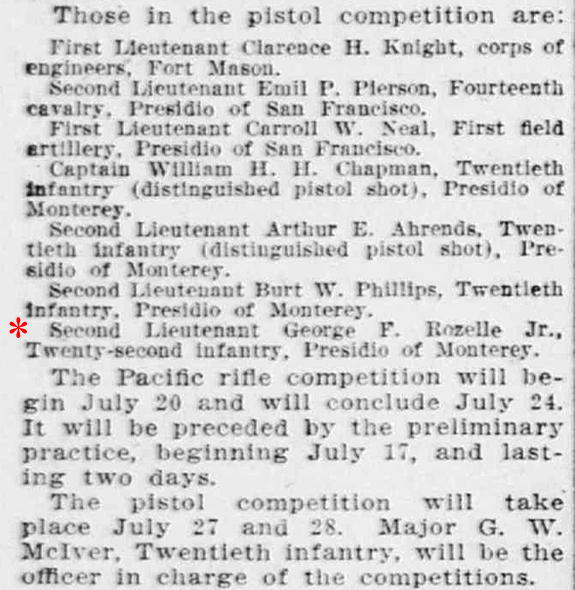 ³
³
The above exerpted article is from the San Francisco Call, Thursday, July 9, 1908 ³
After two days of competition,
Rozelle was in the lead, with the highest scores among all the
shooters.
The following article identifies Lieutenant P.H. Clark as being
from the 22nd Infantry.
He was not, in fact, but was from the 3rd Infantry.
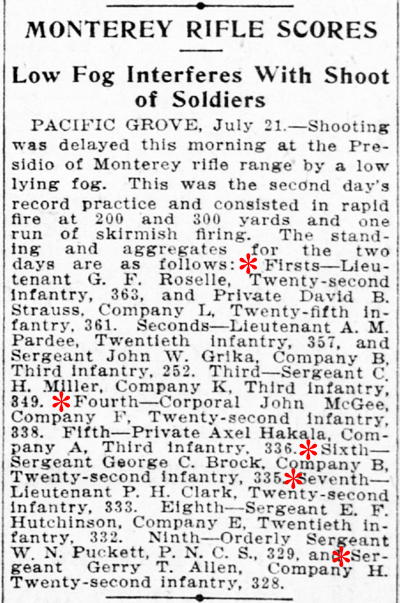 ³
³
The above exerpted article is from the San Francisco Call, Wednesday, July 22, 1908 ³
Bad weather hindered the
shooting, but Rozelle finished second overall,
and was awarded a silver medal. Three other members of the 22nd
Infantry
also made the combined team from the Departments of California
and Columbia.
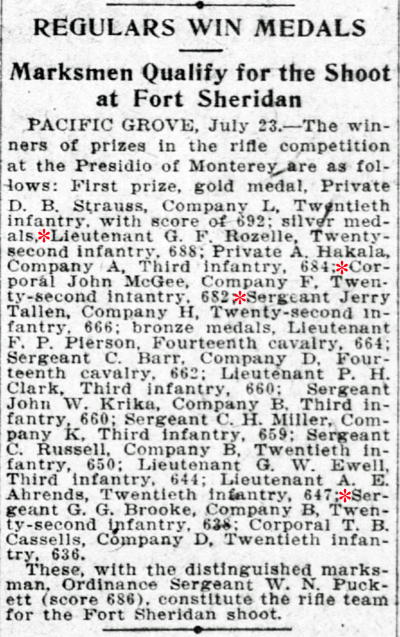
 ³
³
The above exerpted article is from the San Francisco Call, Friday, July 24, 1908 ³
Rozelle and the other three
members of the 22nd Infantry who made the shooting team travelled
to
Fort Sheridan, Chicago, Illinois, in August, 1908, and competed
in the National tournament, but none
of them finished in the top rankings there.
In September 1908, Rozelle joined the Regiment in Alaska, at Fort St. Michael.
On September 12, 1909 he was
promoted to 1st Lieutenant. At that time, there was no available
open position
in the 22nd Infantry for that rank, so, on paper, Rozelle was
assigned to the 9th Infantry. In the records, he was
officially transferred back to the 22nd Infantry on November 30,
1909, though, the whole time, he never left his
duties with the 22nd. Also in November, Rozelle took a leave of
absence, which lasted until January, 1910.
In 1909, Rozelle again qualified as Expert Rifleman.
From January to June of 1910, he
was with the Regiment at Fort Liscum, Alaska. He was attached to
the
1st Infantry, at Vancouver Barracks, Washington, from June to
September, 1910, after which he rejoined the
22nd Infantry at Fort Sam Houston, Texas. In 1911 he again
qualified as Expert Rifleman. From February to December,
1912, he was with the Regiment at El Paso, Texas, and vicinity on
border duty. He then went on a leave of absence
until January 1913. In January, he was detailed to Baton Rouge,
Louisiana, as Professor of Military Science and Tactics,
at Louisiana State University.
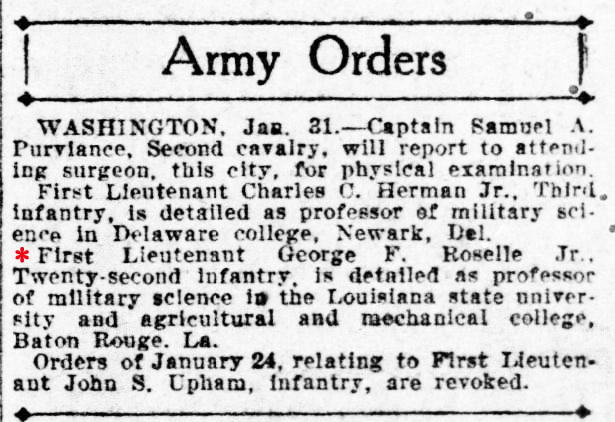 ³
³
The above clipping is from the San Francisco Call, February 1, 1913 ³
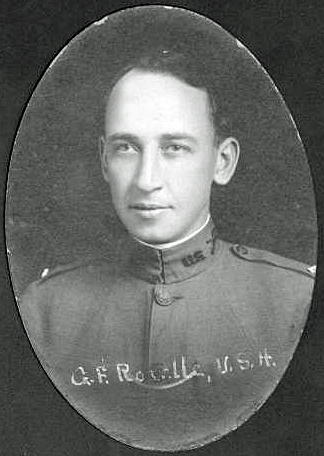 ²
²
George F. Rozelle Jr.,
as Professor of Military Science and Tactics, University Faculty,
Louisiana State University, ca. 1913-1916. At the time this photo
was taken,
Rozelle was a 1st Lieutenant in the 22nd Infantry.
Rozelle taught at LSU from
February 22, 1913, to June of 1916. He was promoted to Captain on
July 1, 1916,
and took a leave of absence during that month, then rejoined the
22nd Infantry at El Paso, Texas. He was sick
in hospital there, during August and September, and then on sick
leave in October. From November, 1916, to April 1917,
he was with the Regiment on border duty at Camp Harry Jones,
Douglas, Arizona. He went with the Regimental Headquarters
and 1st Battalion, to Fort Jay, New York, on April 1, 1917.
During 1917, Rozelle again qualified as Expert Rifleman.
The U.S. entry into World War I
caught the Army unprepared, to meet the high troop levels needed
for participation
in the war in Europe. A nationwide conscription was instituted,
National Guard organizations were Federalized,
and existing Army units were called upon to provide experienced
cadres, to form the cores of new Divisions.
In the summer of 1917, the 22nd
Infantry at Fort Jay was instructed to furnish three officers and
400 enlisted men,
arranged into an organization that would become the nucleus of a
new Army Division. Captain George Rozelle
would be the senior officer from the 22nd Infantry component, and
was assigned to command the Headquarters Company
of this new Division, along with 1st Lieutenant Peter K. Kelly,
and 2nd Lieutenant Charles W. Yuill, also of the 22nd Infantry,
who were to command the first and second companies of the new
Division. The new Division was originally called
the First Expeditionary Division, and soon became known as the
1st Division (Big Red One) of the
American Expeditionary Forces. It was to be the first American
unit to set foot on French soil in World War I.
The Division was organized at
Fort Jay, New York, in May, 1917, and sent overseas as units were
formed, to France,
where it assembled and trained before being placed in the front
lines. Brigadier General William L. Sibert, as Commander of the
Division, took the first components to France in June, 1917,
consisting of his Headquarters staff and a battalion of the 16th
Infantry,
hurriedly formed from other Army units in the States, in order to
give an American presence on the European continent.
Rozelle and the 22nd Infantry components would join the Division
in August.
Of the other two officers from
the 22nd Infantry, 1LT Kelley went on to become Captain and
Adjutant of the 18th Infantry,
and 2LT Yuill would later earn five Silver Star Medals for
gallantry with the 3rd Machine Gun Battalion, both of these units
being part of the 1st Division.
Rozelle was given a temporary
promotion to Major on August 5, 1917, and left for France on
August 7, in command of
Headquarters Troop, and two Companies of Headquarters Train for
1st Division. He was at St. Nazaire, France, from
August 20 to September 2, 1917. He was at Gondrecourt, Meuse,
with Headquarters, 1st Division, to September 16.
He then commanded a Company of the 28th Infantry, at St. Amand,
until November, 1917.
Rozelle was given command of 1st
Battalion, 28th Infantry in December, 1917, and was in the
Luneville Sector until
March, 1918, in the Toul Sector, and Montdidier Sector in April,
1918, while the Division was trained by the French Army,
in preparation for service in the front lines.
Rozelle led 1st Battalion, 28th
Infantry, at the Battle of Cantigny, in May 1918, where he was
awarded the
Distinguished Service Cross.
On July 30, 1918, he was offered
a temporary promotion to Lieutenant Colonel, U.S.A. ( the
designation for the temporary
war-time organization of the US Army ), which he accepted on
August 9, and commanded the Battalion in the
Montdidier-Noyon Defensive and in the Aisne-Marne Offensive, July
18-22, 1918, including the capture of Ploisy,
July 19, and Berzey-le-Sec, July 21. In August, 1918, he was in
the Pont à Mousson Sector.
From August 13, to December 21,
1918, Rozelle was Instructor and Director at the 1st Corps School
at Gondrecourt, France.
He was Provost Marshall, Base Section No. 6, France, January 14
to June 15, 1919. He left France from Marseilles, on July 2,
and landed back in the U.S. on July 17, 1919. He then took a
leave of absence until August 18, 1919.
He was assigned to command of
the 13th Infantry from August 19 to September 7, 1919. On
September 11, 1919,
he became an Instructor at the Infantry School at Camp Benning,
Georgia. He was honorably discharged from the U.S.A.
on February 20, 1920, and reverted back to his rank as Captain in
the Regular Army.
Rozelle was promoted to Major on July 1, 1920.
On July 15, 1920, he was
assigned to the 28th Infantry. He took a leave of absence from
August 2-October 2, 1920.
In November of 1920 he was a member of the Infantry Board of
Review at Washington, D.C. He remained with the
28th Infantry at Camp Dix, New Jersey until February 3, 1921.
He requested, and was granted, a
transfer to the 22nd Infantry on January 24, 1921. He rejoined
the 22nd Infantry on
February 5, 1921 and served with the Regiment at Fort Niagara,
New York and at Fort Jay, Governor's Island, New York,
until June 5, 1922.
On June 7, 1922, Rozelle was
part of the small detachment from the 22nd Infantry who
established the new residence
of the Regiment at Fort McPherson, Georgia. He was at Camp
McClellan, Alabama on duty with the Citizens Military
Training Corps from July 19-August 29, 1922 then returned to Fort
McPherson. He took a leave of absence from
September 23-December 31, 1922.
On December 31, 1922, George F. Rozelle retired from the Army with the rank of Major.
He had served 24 years and 8 months in the Army, 21 years and 10 months of that service with the 22nd Infantry.
The French government bestowed
upon him the title of Chevalier of the Legion of Honor.
He was also twice awarded the French Croix de Guerre with palm.
On June 21, 1930, Rozelle's retirement was increased to the rank of Lieutenant Colonel.
In the Fort McPherson Post
newspaper of November 17, 1922, Rozelle's fellow officer from the
22nd Infantry, Captain Elmer F. Hagler, wrote the following
tribute:
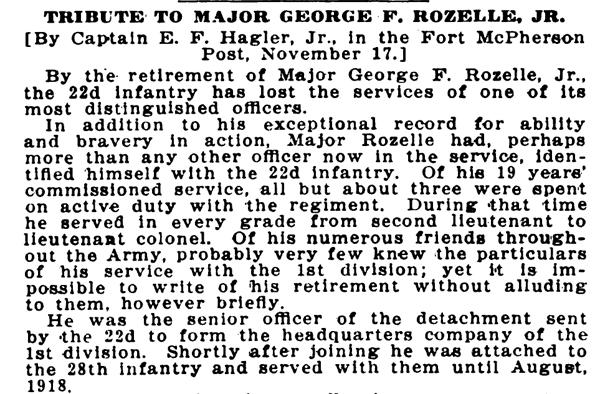
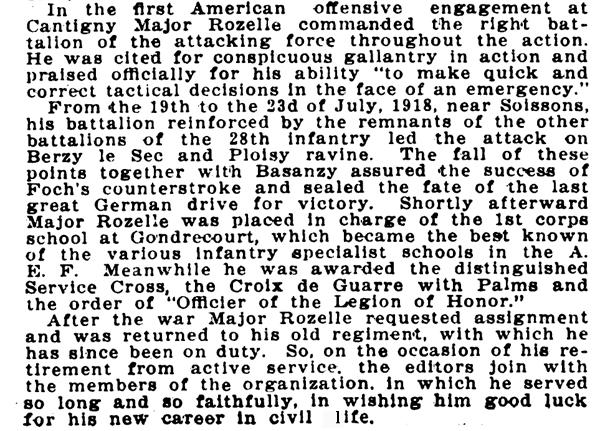
The following is an excerpt of
an article in the New York Times, of August 21, 1918,
announcing the award of the Distinguished Service Cross to George
F. Roselle:
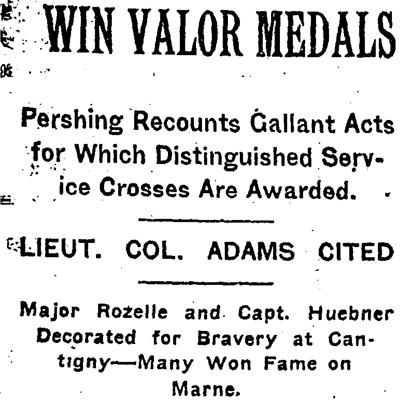
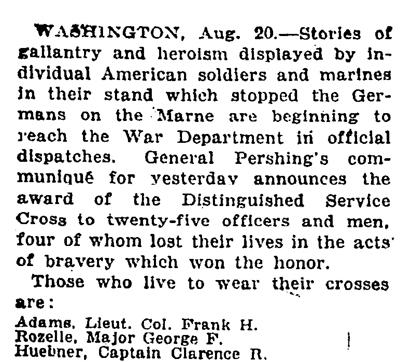
Below is the original General
Order, No. 101, dated November 4, 1918,
awarding the Distinguished Service Cross to George F. Rozelle.
His name is mis-spelled as "Rozella". (marked with a red asterisk)
Note that he is recorded in the
Order, as being a member of the 22nd Infantry,
as his assignment to the 28th Infantry was considered to be only
temporary.
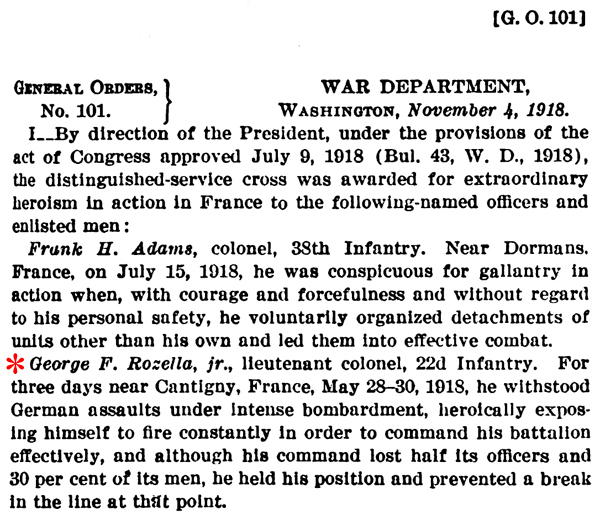
In 1919, the above General Order
was changed, with the creation of a new General Order
by the War Department (War Department General Order No. 15,
1919). Rozelle's name
was corrected, and his unit was given as the 28th Infantry:

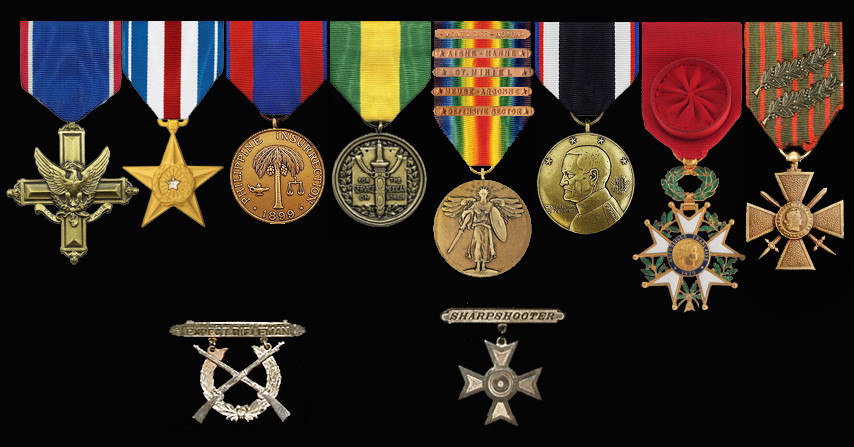
George F. Rozelle's decorations
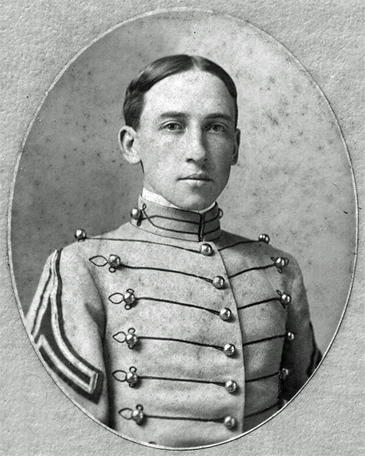
George F. Rozelle in his graduation portrait from the U.S. Military Academy 1903
Photo by: rita from the Find A Grave website
George Francis Rozelle Jr.
NO. 4189 CLASS OF 1903
Died 23 May 1962 at Brooke General Hospital,
Fort Sam Houston, Texas, aged 84 years.
Interment: Boerne, Texas
GEORGE FRANCIS ROZELLE JR., was
born in Little Rock, Arkansas, 19 January 1878. He was a
descendant of
a long line of Virginians whose sons had fought in the
Revolutionary War and the Civil War. A maternal grandfather
was an admiral in the British navy and a paternal grandfather was
surgeon to Napoleon. His great-uncle, Robert Granderson Cole,
Class of 1850, resigned from the U. S. Army but served as a
colonel in the Confederate Army, as Chief of Commissary
under Robert E. Lee. Rozelle was the son of George F. Rozelle and
Sallie Vaughan, whose father had fled from Mississippi
to East Texas with his young daughter and one hundred slaves just
prior to the Civil War. George Rozelle remained a
"Johnny Reb" all his life and on occasion was heard to
give a lusty Rebel yell.
He received his early education
in Mrs Warner's private school in Little Rock and enjoyed every
luxury until he was
in the eighth grade. At that time he was suddenly confronted with
a change in the family's fortunes, and was forced
to leave school in order to help his family. He carried telegrams
for ten dollars a month and attended night school
whenever possible. He tried to get an appointment to the Naval
Academy, but a political maneuver prevented his going there.
However, an appointment to the Point did come through, and he was
assured a higher education. An older brother
sent him to a preparatory school in Highland Falls, New York,
where he saw his first algebra hook at the age of twenty.
His classmates, Longley and Carpenter, long remembered Rozelle's
story of his stay in the Swim Hotel in Highland Falls
and later in Mrs. Myer's boarding house; "Out of the Swim
into the Mire."
He arrived at West Point in 1898
only to discover that there was some doubt about his making the
height requirement,
but someone whispered that if he held his breath, he would pass
the physical.
His first year at the Academy
was a radical change for Rozelle who had had no formal high
school training, but he
was quickly initiated by the upperclassmen when he went to
"beast barracks." He was dubbed "Mister Razzle
Dazzle"
by the upperclassmen, a name that he was called throughout the
rest of his life.
Razzle Dazzle lived in fear of
being found deficient in his studies and often put blankets over
his window to gain
extra study time after "Lights Out" at ten o'clock. Of
all the tales of his plebe year that he loved to recount to his
family,
perhaps his favorite story was about his fight when he was called
out for having been "B.J." Hazing was at its height
at the time, and Razzle, who had a ready tongue, was also a
master at mimicry; when he was called upon to sound off,
he delivered verbal stilettos coupled with humor and sarcasm at
the upperclassmen. After the first-term exams
he fought barefisted against a selected adversary who not only
out-weighed him but was a head taller. He gave
a good account of himself, and as a result both men spent a week
in the hospital. Having survived the hazing
or "exercising," Razzle Dazzle apparently gained a
certain respect. He was never known to criticize the rough
treatment
meted out to the Plebes, but took it as a part of West Point
tradition. He always praised the Academy as the greatest
character building institution in the United States. Rozelle
graduated with the Class of 1903, having had instilled in him
a sacred regard for Duty, Honor, and Country.
His first assignment was to
Mindanao, P. I., where he chased Dato Allee and the wild Moro
natives. For this service
he was awarded the Philippine Medal. He was on duty at San
Francisco during the great fire and earthquake.
Later he spent a tour of duty in Alaska and at various posts in
the United States.
Probably one of his happiest
assignments was at the Louisiana State University where he served
as Professor of
Military Science and Tactics. His mother and a younger sister
joined him here, and together they acted as his hostesses.
Many of the friends he made here later became business associates
when he entered the oil coloration business
in Louisiana following his retirement.
When World War I began, Major
Rozelle was stationed at Governors Island, New York. He
immediately volunteered
to go to France and landed there on 20 August 1917 with the 28th
Infantry, 1st Division, the first American outfit to enter the
war.
The division's first combat engagement was at Cantigny, France.
and it was here that Major Rozelle, as commander
of the first of three battalions ( Right) took Cantigny, the
first French town to be taken by American forces.
George F. Rozelle's conduct during this battle is best recorded
in an official communique by General Pershing
when the Distinguished Service Cross was awarded to him:
"Major George F. Rozelle
Jr., Infantry, for three days near Cantigny, France, May 28,
1918, withstood the German assaults
under intense bombardment, heroically exposing himself to fire
constantly in order to command his battalion effectively.
And although his command lost half its officers and 30 percent of
its men, he held his position and prevented
a break in the line at that point."
The official citation by General Bullard reads:
"Major George F. Rozelle
performed his duty in most dangerous and trying circumstances and
made quick
and practical decisions at critical moments."
It was also for this action at Cantigny that he was awarded his first Croix de Guerre with palm by the French government.
Less than two months later,
during the fighting in the Ploisy and Berzy-le-Sec areas, he
again conducted himself
in such an exceptional manner in battle that he was awarded the
Silver Star by the United States government, and the
War Cross and the Legion of Honor by the French government. The
award presentation of the Legion of Honor
was made by General Farnsworth after Colonel Rozelle had returned
to the United States and was serving
as an infantry instructor at Fort Benning.
The quotation which follows was
one of Colonel Rozelle's favorites because it took into account
the soldiers under his command,
the doughboys whom he always felt had sacrificed and given so
much, including their lives, and yet often received little
or no recognition for their sacrifices:
"Colonel Rozelle: The great
French Republic, previous to this date, has expressed to you its
appreciation of your services,
in the attack and defense of Cantigny, by bestowing upon you its
war cross—the Croix de Guerre. Now it requests
that it be authorized by our government to present to you its
higher decoration— the Legion of Honor. This is a token
of its appreciation of further and greater services toward the
world, of yourself and the valiant 1st Battalion of the 28th
Infantry
in capturing the two strategical towns of Ploisy and Berzy-le-Sec
on July 19th and 20th, 1918. ...
"However, this
medal—this badge of the Legion of Honor—distinguishes a
soldier from his fellow soldiers, even though
they have done their full and loyal duty to their country in
every respect. It denotes a degree of initiative and
aggressiveness
not found in most men.
"It will cause your further
career to be watched, with interest and with hope for your
future, by persons who might otherwise
have passed you by without notice.
"To most men the
opportunity to win this medal never comes. Many men to whom the
opportunity does come, permit it
to slip by unnoticed or unaccepted. The opportunity came to you
and you accepted it. You have won a decoration
that expresses the gratitude and esteem and trust of a great and
loving nation. We congratulate you."
During the last months of World
War I, after intensive frontline service, he was assigned as an
instructor to the
officers school at Gondrecourt, France. One of his students here
was a brilliant young Texan—
soon to become A close friend—Beauford Jester, later
Governor of Texas.
On 31 December 1922, George F.
Rozelle wrote "Finis" to his active participation in
things military; he was retired
from the Army with a physical disability in the rank of
lieutenant colonel.
He later became associated with
General Campbell B. Hodges and W. H. Hodges in the oil and gas
business
in the Shreveport, Louisiana, area. Dallas became his
headquarters, and it was here that he met a young University of
Texas
co-ed, Miss Erma Smith of Dallas, who was 26 years his junior. He
reluctantly entered Dallas politics at the insistence
of a group of Dallas businessmen and became a candidate for Water
Commissioner. Rozelle was not a politician
and frankly admitted it on the stump. After much campaigning,
punctuated with courting the young co-ed, he was defeated
in the election by a few votes. He often said later, that had he
won in politics he might have lost in love.
Razzle Dazzle's bachelorhood
came to an end in 1930 when he married Miss Smith after a
three-year courtship.
Two years later his happiness reached a new height when his son,
"Pete" was born. He thought Pete would be
the last son of the Class, but MacArthur's son won that
distinction.
The year 1935 found the Rozelle
family the owners of a farm 25 miles north of San Antonio, Texas,
near the town of Boerne.
This farm had a river running in front of the hundred-year-old
farmhouse, which was on a little country lane far from
the stir of the city. Colonel Rozelle became a plain dirt farmer,
raising sheep and operating an experimental apple orchard.
He spent much time with his young son teaching him to hunt, fish,
and to build boats. He proved that fancy apples
could be grown in that area, but found the details of marketing
distasteful, and when labor difficulties developed
during World War II he abandoned the orchard. The years he spent
on this hill-country farm, enjoying the close
companionship of his wife and son, were some of the happiest of
his life.
The next few years found George
Rozelle a frequent visitor on the Texas A.&M. campus at
College Station where his son
was a student. He had hoped that his son would go to the Point,
but showed no disappointment when young Pete
turned down two appointments and chose petroleum engineering as a
profession instead of the Army.
George Rozelle served as
chairman of the Democratic executive committee of Kendall County
and also as vestryman
in St. Helena's Episcopal Church of Boerne.
His love and unselfish devotion
to his family, first to his mother, father, and three sisters
until their death, and then
to his second family, as he called it, were probably the highest
manifestations of his whole life. No written word
could do justice to his fine personal qualities that ennobled his
life. His unassuming gentility, kindliness, and generosity
were outstanding characteristics. His conversation rarely
included "Army" and he frowned upon arrogance; he
detested
the officer who made a subordinate an underling. His love of
truth, as it was ingrained in him at West Point, his meticulous
orderliness, and his charming, genteel manner will always be
remembered by those who knew him best. He was inflexible
in his own high standard of honor; to compromise with evil was to
let the Devil win. To the end he represented
the best and proudest traditions of West Point.
An old stomach ailment, which
had caused his early retirement, returned more frequently during
the last three years
of his life, and bouts with hemorrhages and pneumonia finally
took their toll. He walked into the hospital on 15 May,
after a slight stomach hemorrhage, contracted pneumonia, and
eight days later, on the morning of 23 May 1962,
he died in his sleep in the presence of his wife.
He was buried in the Boerne
Cemetery, surrounded by the hills that he loved, with full
military honors.
Father James Joseph of St. Paul's Episcopal Church of San Antonio
conducted the last rites. He is survived
by his widow Erma; one son, F. McQueen Rozelle of Oklahoma City,
Oklahoma; two grandchildren,
Rita and F. McQ. Rozelle Jr.; and two nephews, Stanley Krogstad
of Tullahoma, Tennessee,
and Vaughan Rozelle of Dallas, Texas.
Taps for one who exemplified the
best traditions of the Corps and who represented to the highest
degree
the precepts of Duty, Honor, and Country:
"Thou shalt lie down
With patriarchs of the infant world—with kings,
The powerful of the earth—the wise, the good
True forms, and hoary seers of ages past
All in one mighty sepulcher.
All that breathe will share thy destiny." ¹
Burial:
Boerne Cemetery
Boerne
Kendall County
Texas, USA
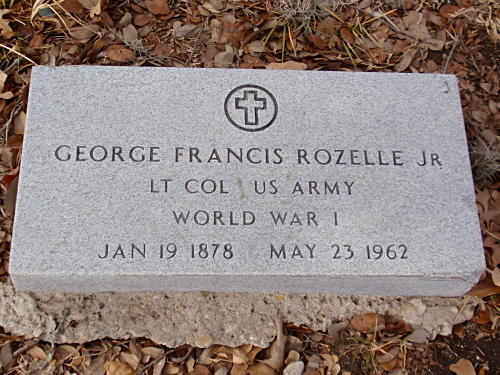
Grave marker for George F. Rozelle Jr.
Photo by M. Dahl from the Find A Grave website
¹ ASSEMBLY Volume XXIV Spring 1965 No. 1,
Published by
the West Point Alumni Foundation, Inc., West Point, N.Y.
² LSU Photograph Collection, 1886-1926,
Louisiana State University Archives, LSU Libraries, Baton Rouge,
LA.
Collection URL http://www.lib.lsu.edu/special/archives/digital
³ CDNC California Digital Newspaper Collection
Home | Photos | Battles & History | Current |
Rosters & Reports | Medal of Honor | Killed
in Action |
Personnel Locator | Commanders | Station
List | Campaigns |
Honors | Insignia & Memorabilia | 4-42
Artillery | Taps |
What's New | Editorial | Links |